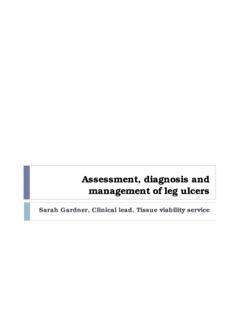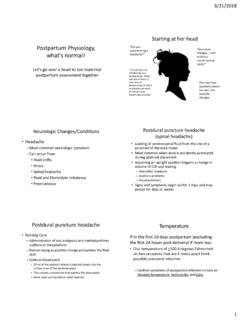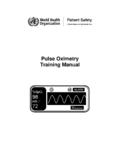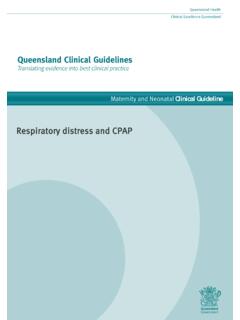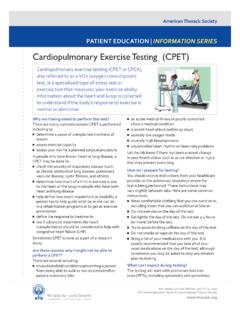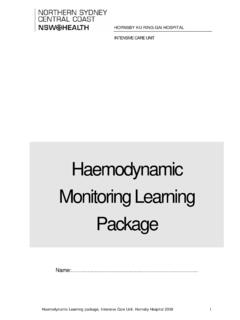Transcription of Unit 48: Prepare for and Take Physiological Measurements
1 Unit 48: Prepare for and Take Physiological Measurements Unit reference number: K/616/7353. Level: 3. Unit type: Optional Credit value: 3. Guided learning hours: 23. Unit summary Care workers will often need to undertake and record an individual's Physiological Measurements . This may be for general routine monitoring of their body functions or for more specific reasons, for example as part of certain medical treatments. These Measurements can include one or more of the following: body temperature, blood pressure , respiratory rate, pulse rate, body mass index. While carrying out these Measurements , it is essential to maintain the individual's comfort, respect and dignity, as well as applying standards of hygiene and infection control precautions.
2 In this unit, you will learn why we may need to monitor and record basic Physiological Measurements . You will be required to demonstrate your skills in using the various equipment as part of this process, in line with manufacturers'. instructions and following required health and safety measures. You will need to display patience and empathy towards individuals, and respect their privacy. In order to monitor the Measurements in line with workplace procedures and healthcare requirements, you will need to update necessary records. As defined by the assessment strategy, centres should ensure that assessors assessing this unit are technically competent and possess the relevant occupational knowledge.
3 The assessment strategy can be found in Annexe A of the associated qualification specification. 978 1 446 95316 7 Pearson BTEC Level 2 Diploma in Care (England) 1. Unit Issue 1 January 2018 Pearson Education Limited 2018. Learning outcomes and assessment criteria To pass this unit, the learner needs to demonstrate that they can meet all the learning outcomes for the unit. The assessment criteria outline the requirements the learner is expected to meet to achieve the unit. Learning outcomes Assessment criteria 1 Understand relevant legislation, Describe current legislation, policy and good practice for national guidelines, organisational undertaking Physiological policies and protocols affecting Measurements work practice 2 Understand the Physiological Explain the principles of blood states that can be measured pressure to include: blood pressure maintenance differentiation between systolic and diastolic blood pressure normal limits of blood pressure conditions of high or low blood pressure Explain the principles of body temperature to include.
4 Body temperature maintenance normal body temperature pyrexia, hyper-pyrexia and hypothermia Explain the principles of respiratory rates to include: normal respiratory rates factors affecting respiratory rates in ill and well individuals Explain the principles of pulse rates to include: normal pulse rates limits factors affecting pulse rates . raising or lowering pulse sites on the body the requirement for pulse oximetry Measurements analysis and implication of pulse oximetry findings Explain the principles of body mass index (BMI) in relation to weight/dietary control Explain the major factors that influence changes in Physiological Measurements Explain the importance of undertaking Physiological Measurements Explain how Physiological Measurements may need to be adapted for the individual 2 978 1 446 95316 7 Pearson BTEC Level 2 Diploma in Care (England).
5 Unit Issue 1 January 2018 Pearson Education Limited 2018. Learning outcomes Assessment criteria 3 Be able to Prepare to take Explain to the individual the Physiological Measurements Measurements that will be taken and why they are required Reassure the individual during the Physiological Measurements process in line with agreed ways of working Answer questions and deal with concerns during the Physiological Measurements process in line with agreed ways of working Explain the help individuals may need before taking their Physiological Measurements Explain why it may be necessary to adjust an individual's clothing before taking Physiological Measurements
6 Ensure all materials and equipment to be used are appropriately prepared in line with agreed ways of working Confirm the individual's identity and obtain valid consent in line with agreed ways of working 4 Be able to undertake Physiological Apply standard precautions for Measurements infection prevention and control in line with agreed ways of working Apply health and safety measures relevant to the procedure and environment Select and use appropriate equipment at the prescribed time and in the prescribed sequence to obtain an accurate measurement Monitor the condition of the individual throughout the measurement in line with agreed ways of working Respond to any significant changes in the individual's condition in line with agreed ways of working 978 1 446 95316 7 Pearson BTEC Level 2 Diploma in Care (England) 3.
7 Unit Issue 1 January 2018 Pearson Education Limited 2018. Learning outcomes Assessment criteria Follow the agreed process when unable to obtain or read a Physiological measurement Identify any issues outside own responsibility and refer these to other colleagues 5 Be able to record and report results Explain the necessity for recording of Physiological Measurements Physiological Measurements Explain common conditions that require recording of Physiological Measurements Demonstrate the correct process for reporting Measurements that fall outside the normal levels in line with agreed ways of working Record accurately using the correct documentation
8 Physiological Measurements taken in line with agreed ways of working 4 978 1 446 95316 7 Pearson BTEC Level 2 Diploma in Care (England). Unit Issue 1 January 2018 Pearson Education Limited 2018. Content What needs to be learned Learning outcome 1: Understand relevant legislation, policy and good practice for undertaking Physiological Measurements Physiological Measurements Measurements that determine how well the body is functioning. Types of measurement, temperature, height, weight, body mass index (BMI), blood pressure taken manually or electronically, pulse rates at a variety of sites, radial pulse , pulse oximetry, respiratory rate.
9 Relevant legislation Health and Safety at Work etc. Act 1974. Data Protection Act 1998. Care Act 2014. Manual Handling Operations Regulations 1992. Equality Act 2010. Health and Social Care Act 2008. The Essential Standards of Quality and Safety (Care Quality Commission). National guidelines National Institute for Health and Care Excellence (NICE) guidelines. Agreed ways of working Policies and procedures where they exist. Referencing to and updating the individual's care plan where appropriate. Learning outcome 2: Understand the Physiological states that can be measured Individual Someone requiring care or support; it will usually mean the person or people supported by the learner.
10 Principles of blood pressure blood - pressure maintenance: o blood flow o heart rate o systemic circulation. Differentiation between systolic and diastolic blood pressure : o arterial pressure o ventricular contraction o ventricular relaxation. Normal limits of blood pressure . Conditions of high- or low blood pressure : o causes o hypotension o hypertension. 978 1 446 95316 7 Pearson BTEC Level 2 Diploma in Care (England) 5. Unit Issue 1 January 2018 Pearson Education Limited 2018. What needs to be learned Principles of body temperature Body temperature maintenance: o balance of heat o receptors o respiration o evaporation o hypothalamus.











